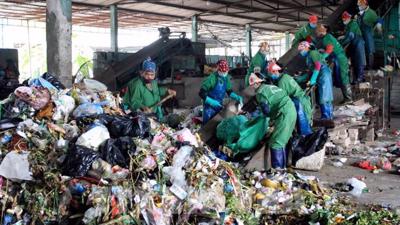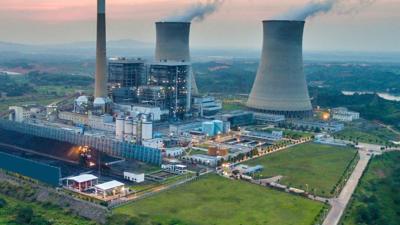For sustainable finance development
Green and sustainable finance is no longer simply an option for Vietnam as it shifts towards a low-carbon economy and strives to meet its development targets.

Vietnam’s green and sustainable finance market remain in its early stages of development. Delays in issuing legal frameworks and the absence of strong incentives to channel capital into sustainable sectors remain persistent challenges that have yet to be effectively addressed.
Speaking at a recent seminar, Mr. Thomas Jacobs, Country Manager of the International Finance Corporation (IFC) for Vietnam, Cambodia, and Laos, emphasized that for Vietnam to achieve high-income status by 2045, a shift towards a low-carbon economy is essential. In this transition, green and sustainable finance is not just an option, it is a fundamental pillar for ensuring long-term growth and competitiveness.
Progress made, but challenges remain
According to Mr. Jacobs, Vietnam faces significant risks from climate change, posing major challenges to its goal of becoming a high-income nation by 2045. Numerous environmental reports highlight the threats the country must confront, including rising temperatures and droughts in the north, typhoons and flooding in the central region, and saltwater intrusion in the Mekong Delta, the country’s agricultural heartland.
The Vietnam Country Climate and Development Report by the World Bank estimates that Vietnam will need to mobilize $368 billion for climate action by 2040, with $184 billion expected to come from the private sector.
Mr. Nguyen Tung Anh, Senior Manager, Credit Risk Research and Head of Sustainable Finance Services at FiinRatings, noted that green finance is gradually taking root. According to the credit rating agency, green credit has grown consistently and significantly since 2015, with an impressive surge from 2020 onwards, reaching an estimated VND679 trillion ($27.16 billion) as of the end of 2024. Compared to the overall credit growth rate of 12-15 per cent annually from 2018 to 2024, green credit has expanded at a much faster pace, with some years, such as 2018 and 2021, recording growth of up to 30 per cent.
Leading banks such as VietinBank, ACB, Agribank, and MB are not only embracing the green finance trend but are also proactively developing their own standards for green lending. These initiatives create greater flexibility in financing mechanisms and expand access to green capital. BIDV, for example, has introduced a green project portfolio with preferential interest rates and exchange rates while gradually phasing out credit for high-carbon-emitting industries such as steel, cement, and fertilizers. Similarly, VietinBank and ACB have introduced sustainable finance frameworks, demonstrating both their commitment and the broader transformation of Vietnam’s financial sector towards sustainability.
Vietnam’s green bond market is also showing encouraging signs. Data from FiinRatings indicates that the issuance of sustainable bonds (GSS) has surged in recent years, reaching an estimated VND6.875 trillion ($275 million) in 2024, up from VND2.5 trillion ($100 million) in 2023.
Beyond existing sustainable investment funds, new investment models are emerging, offering more options for investors focused on sustainable finance. A key milestone in this space is Eastspring’s EVESG Fund, which conducted Vietnam’s first independent ESG (environmental, social, and governance) fund assessment.
Despite this momentum, Mr. Jacobs cautioned that the pace of green finance adoption in Vietnam remains sluggish, with no significant breakthroughs as yet.
Key step for sustainable finance
Vietnam has yet to establish a comprehensive green taxonomy, leaving a crucial gap in the country’s sustainable finance framework. According to Mr. Tung Anh, the availability of professionals with strong expertise in ESG and green finance remains limited, as these emerging requirements demand interdisciplinary knowledge spanning finance, engineering, environmental science, and regulatory compliance. Additionally, the absence of a clear legal framework and limited in-house expertise pose risks for businesses, including accusations of “greenwashing”.
Experts emphasize that establishing a green taxonomy in Vietnam is crucial for transitioning to a sustainable, low-carbon, and climate-resilient economy. A green taxonomy provides a standardized and harmonized approach to defining and identifying sustainable activities. Vietnam’s national green taxonomy must address domestic needs while aligning with international investor expectations. This ensures that national priorities are met without creating additional barriers to cross-border sustainable capital flows. Regulatory oversight of such classifications will also play a key role in supporting green credit.
According to Decree No. 08/2022/ND-CP, the Ministry of Natural Resources and Environment (now the Ministry of Agriculture and Environment) was required to submit the national green taxonomy to the government by December 31, 2022. However, it remains in draft form and has yet to be officially issued. Moreover, experts highlight that high costs deter many businesses from entering the green finance market.
Issuing green bonds involves not only working with issuance advisory firms but also undergoing complex verification processes. Companies must secure third-party validation of their compliance with green bond frameworks and, depending on the nature of the project, may also require experts to assess green products or sustainable buildings. Notably, green bond interest rates do not significantly differ from conventional bonds, while issuance costs are considerably higher.
To develop Vietnam’s green bond market and other labeled bonds, experts recommend that government agencies establish clear guidelines for issuance, certification, and reporting while also introducing incentive policies to encourage issuance and investment. Experts also suggest that the Vietnamese Government consider issuing “green government bonds” as a model to provide a strong foundation for the domestic labeled bond market.
Additionally, international collaboration within sustainable finance networks can be leveraged to support Vietnam’s efforts to advance its sustainable financial market. Participation in these networks can enhance knowledge-sharing, promote best practices, increase awareness among stakeholders, foster policy commitments, and build capacity across relevant sectors.
Unlocking the potential of sustainable financial markets requires addressing complex challenges. Analysts recommend that policymakers prioritize actions strategically and accelerate implementation to unlock capital flows for sustainable growth.
"According to data, while the banking system holds up to 80 per cent of domestic savings, only 5.4 per cent of that is allocated to climate-related projects. Additionally, the total issuance of green, social, and sustainability bonds from 2016 to 2024 reached only $1.4 billion; a modest figure compared to its potential."
Mr. Thomas Jacobs, Country Manager of the International Finance Corporation (IFC) for Vietnam, Cambodia, and Laos







![[Interactive]: Economic overview - April 2025](https://media.vneconomy.vn/400x225/images/upload/2025/05/06/5a245778-67b1-4874-a8dc-21f8cfed62a6.png)